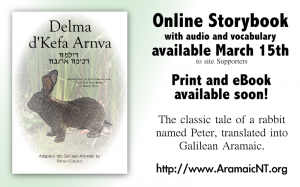
So in forcing myself to work harder on writing that book, I’ve decided to do a bit of freestyle thinking aloud on The Aramaic Blog (which after all what else are blogs for?). The bulk of the book itself is about Aramaic in modern times, how it expresses itself in popular culture and why it is such an important family of languages to study. As such, I suppose I should ponder upon the weightiest of those three topics and dive right in:
Why *is* Aramaic so important?
Usually when people answer this question, they start out with something like, “Aramaic has a history that spans over 3000 years and is one of the oldest continually written languages we have on record, blah blah blah…” which is all nice and good, except that it is the kind of dross that 1) can put you to sleep before you can say “lelya tav” and 2) because of this, it appeals to a very small group of people (mainly nerdly and academic individuals such as myself).
What I *need* to do is find a way to make it relevant for a modern readership. Find topics that engage the average individual and give them a sense of ownership towards learning more about the language on their own (in essence, pique their interest so they *want* to learn).
Again, from *this* angle, the stock answer is to say “Well it’s the language of Jesus!” That tends to snap up the attention of at least ~2 billion people. But I want to interest more.
Say, “It was the tongue of the ancient rabbis and the language at the very foundation of Modern Judaism” and then you have another ~13.3 million interested.
But if you think about it, those two groups (i.e. adherents to Christianity and Judaism respectively) are the obvious ones. Every Christian has read the words “talitha koumi” or “eli eli lama sabachthani” and wondered, and every Jew has heard the Kaddish recited on various occasions. Who else can find Aramaic *important*?
Say, “Syriac Aramaic had an influence upon early Islam and Nabatean Aramaic’s script is the mother of modern Arabic calligraphy,” and you might make a handful of Arabic purists very upset, but you also might snag the attention of another ~1.5 billion people.
Then if you say, “Aramaic was one of the languages used to spread early Buddhism,” you’ll have piqued the curiosity of another ~500 million people.
Putting all of these numbers together, we can see that with our rough estimate, *~4.1 billion people* have some important connection to Aramaic that is related to their *faith* (something which is certainly of personal interest). Out of a world of roughly 6.5 billion people in total, that means that ~2/3rds of individuals upon the face of the earth have an Aramaic influence upon their religion.
This number also doesn’t include other vectors for Aramaic’s prominence (further writing system influences, the languages of empires that shaped the ancient world, etc.), as well as all of the minority faiths (Mandaism, Zoroastrianism, Kabalism) and even Aramaic’s fractured legacy today that rests upon ~2 million Neo-Aramaic speakers.
Because of this large interest, Aramaic has also been given recent attention in the media. Between horribly mistaken tattoos obtained by foolhardy celebrities to movies such as The Passion of the Christ and truly extraordinary claims about interpreting the Lord’s Prayer, and “true” meanings behind various Aramaic words, the language has developed a considerable amount of “folklore” in modern times.
But since there is so little reliable information about it which is available to the public, and the almost unbelievable disconnect and separation between Aramaic in the public sphere and the very scholars who study it, we see too many people riding upon the excitement, but failing to do their homework.
That is what I hope to influence in writing such a book. I want to bring Aramaic to the forefront so that the average layman amongst those ~4 billion people can walk away confidently with the tools they need to quench the thirst to learn more on their own.
Peace,
-Steve




